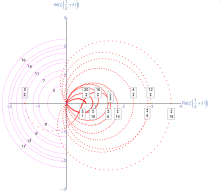User:Jgmoxness/sandbox
| Dual Snub 24-cell | ||
 Orthogonal projection | ||
| Type | 4-polytope | |
| Cells | 96 
| |
| Faces | 432 | 144 kites 288 Isosceles triangle |
| Edges | 480 | |
| Vertices | 144 | |
| Dual | Snub_24-cell | |
| Properties | convex | |
In geometry, the dual Snub_24-cell is a convex uniform 4-polytope composed of 96 regular cells. Each cell has faces of two kinds: 3 kites and 6 isosceles triangles. The polytope has a total of 432 faces (144 kites and 288 isosceles triangles) and 480 edges.

The (42) yellow have no overlaps.
The (51) orange have 2 overlaps.
The (18) tetrahedral hull surfaces are uniquely colored.
Semiregular polytope[edit]
It was discovered by Koca et al. in a 2011 paper.[1]
Coordinates[edit]
The vertices of a dual snub 24-cell are obtained through non-commutative multiplication of the simple roots (T') used in the quaternion base generation of the 600 vertices of the 120-cell. The following orbits of weights of D4 under the Weyl group W(D4):
O(0100) : T = {±1,±e1,±e2,±e3,(±1±e1±e2±e3)/2}
O(1000) : V1
O(0010) : V2
Constructions[edit]
One can build it from the subsets of the 120-cell, namely the 24 vertices of T=24-cell, 24 vertices of the alternate T'=D4 24-cell, and 96 vertices of the alternate snub 24-cell S'=T' n=1-4 using the quaternion construction of the 120-cell and non-commutative multiplication.
| Dual Snub 24-cell |
|---|
 |
Dual[edit]
The dual polytope of this polytope is the Snub 24-cell.
See also[edit]
Notes[edit]
References[edit]
- T. Gosset: On the Regular and Semi-Regular Figures in Space of n Dimensions, Messenger of Mathematics, Macmillan, 1900
- H. S. M. Coxeter (1973). Regular Polytopes. New York: Dover Publications Inc. pp. 151–152, 156–157.
- Snub icositetrachoron - Data and images
- 3. Convex uniform polychora based on the icositetrachoron (24-cell) - Model 31, George Olshevsky.
- Klitzing, Richard. "4D uniform polytopes (polychora) s3s4o3o - sadi".
- John H. Conway, Heidi Burgiel, Chaim Goodman-Strass, The Symmetries of Things 2008, ISBN 978-1-56881-220-5 (Chapter 26)
- Snub 24-Cell Derived from the Coxeter-Weyl Group W(D4) [1], Mehmet Koca, Nazife Ozdes Koca, Muataz Al-Barwani (2012);Int. J. Geom. Methods Mod. Phys. 09, 1250068 (2012)
- Quaternionic representation of snub 24-cell and its dual polytope derived from E8 root system, Mehmet Koca, Mudhahir Al-Ajmi, Nazife Ozdes Koca (2011);Linear Algebra and its Applications,Volume 434, Issue 4 (2011),Pages 977-989,ISSN 0024-3795
DualSnub24Cell

The first failure of Gram's law occurs at the 127'th zero and the Gram point g126, which are in the "wrong" order.
-
Caption1
-
Caption2
1 test 2 math>{\tilde{A}}_{2}</math> 3

=[3[3]]








